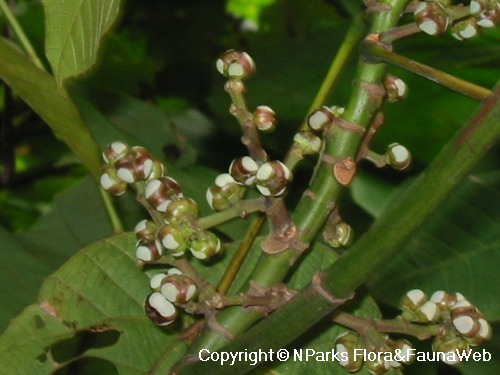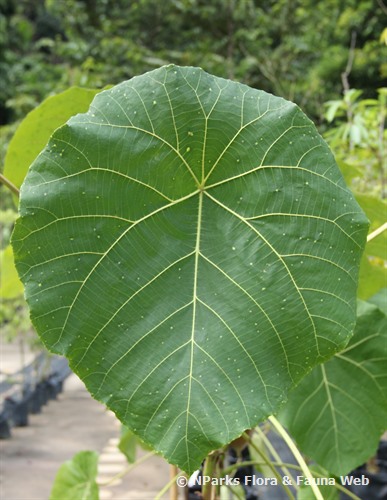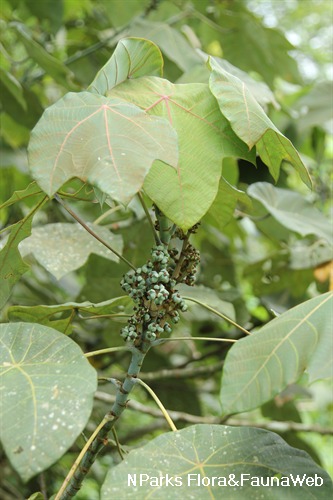.jpg)
Back
Macaranga gigantea (Rchb.f. & Zoll.) Müll.Arg.
| Family Name: | Euphorbiaceae |
| Synonyms: | Macaranga megalophylla (Müll.Arg.) Müll.Arg. |
| Common Name: | Mahang Gajah, Elephant's Ear Tree, Giant Mahang, Telingga Gajah, Kubin, Kubang, Mengkubang |
Macaranga gigantea or Mahang Gajah is a small to medium sized tree native to Singapore. Growing to a height of 15 m tall, it produces large, trilobed, coarsely toothed leaves that can reach 60 cm in length. Red dots are scattered on the underside of the leaves. The flowers are borne on a densely branched inflorescence. The male inflorescences are larger, measuring to 50 cm long while the smaller female inflorescences measure to about 15 - 25 cm long. The fruit is a bi-lobed, yellow, sticky capsule that split upon maturity.
Name
Classifications and Characteristics
| Plant Division | Angiosperms (Flowering Seed Plants) (Dicotyledon) |
|---|---|
| Plant Growth Form | Tree (Small (6m-15m), Medium (16m-30m)) |
| Mode of Nutrition | Autotrophic |
Biogeography
| Native Distribution | Myanmar, Malay Peninsular, Sumatra, Borneo, Sulawesi |
|---|---|
| Native Habitat | Terrestrial (Secondary Rainforest) |
| Preferred Climate Zone | Tropical |
| Local Conservation Status | Native to Singapore (Least Concern (LC)) |
Description and Ethnobotany
| Growth Form | It is small to medium sized tree with pale brown to whitish bark that can reach to 15 m, rarely to 25 m tall. |
|---|---|
| Foliage | The leaves are large, leathery, broadly egg-shaped, tri-lobed measuring to 60 cm long by 50 cm wide. Margins are coarsely toothed with small cup-like gland on each tooth while the midrib and lateral veins are slightly covered in coarse grey tufted hairs. Leaves are dull green above, pale below with scattered tiny red dots below. The stalk is attached 4 - 13 cm from the base of the leaf (peltate). The stipules are fairly persistent, oblong, papery, erect measuring to 45 mm long by 25 mm wide. |
| Flowers | Flowers are dioecious where the male and female flowers are produced on different trees. Flowers are borne on a densely branched inflorescence, irregularly spaced in groups of 10 -15 flowers. The male inflorescence is larger, measuring to 50 cm long by 24 cm wide while the female inflorescence is smaller, measuring 15 - 25 cm long. Each flower is papery, persistent bracts are overlapping, irregularly toothed, egg-shaped, covered in short, fine grey hairs, measuring to 5 mm long by 4 mm wide. |
| Fruit | The fruit is a 2-lobed, yellow, sticky capsule, measuring 4 - 5 mm long by 6 - 8 mm wide. Lobes are almost round, each containing 1 slightly flattened seed with a violet-coloured seed covering (aril). |
| Habitat | Occurs in secondary and lowland forests. <1&2> |
| Cultivation | It can be propagated by seed. |
Landscaping Features
| Desirable Plant Features | Ornamental Foliage |
|---|
Plant Care and Propagation
| Light Preference | Full Sun |
|---|---|
| Water Preference | Moderate Water |
| Plant Growth Rate | Moderate |
| Rootzone Tolerance | Well-Drained Soils, Moist Soils, Fertile Loamy Soils |
Foliar
| Foliage Retention | Evergreen |
|---|---|
| Mature Foliage Colour(s) | Green |
| Foliar Type | Simple / Unifoliate |
| Foliar Arrangement Along Stem | Alternate |
| Foliar Attachment to Stem | Petiolate |
| Foliar Shape(s) | Non-Palm Foliage (Ovate) |
| Foliar Venation | Reticulate |
| Foliar Margin | Serrate / Toothed |
| Foliar Apex - Tip | Acute |
| Foliar Base | Rounded / Obtuse |
Non - Foliar and Storage
| Stem Type & Modification | Woody |
|---|
Floral (Angiosperm)
| Flower & Plant Sexuality | Unisexual Flowers , Dioecious |
| Flower Colour(s) | Green |
|---|
| Flower Grouping | Cluster / Inflorescence |
| Flower Location | Axillary |
| Flower Symmetry | Radial |
| Inflorescence Type | Panicle |
Fruit, Seed and Spore
| Mature Fruit Colour(s) | Yellow / Golden |
|---|---|
| Mature Fruit Texture(s) | Sticky |
| Fruit Classification | Simple Fruit |
| Fruit Type |
References
| References | <1> Gardner, S., Sidisunthorn, P. & Chayamarit, K. (2016). Forest Trees of Southern Thailand, vol. 2, pp. 800. Bangkok: The Forest Herbarium, Department of National Parks, Wildlife and Plant Conservation. <2> Van Welzen, P.C. & Chayamarit, K. (2007). Euphorbiaceae. Flora of Thailand, vol. 8(2), pp. 305-592. Bangkok: The Forest Herbarium, Department of National Park, Wildlife and Plant Conservation. |
|---|
Image Repository
Others
| Master ID | 1945 |
|---|---|
| Species ID | 3237 |
| Flora Disclaimer | The information in this website has been compiled from reliable sources, such as reference works on medicinal plants. It is not a substitute for medical advice or treatment and NParks does not purport to provide any medical advice. Readers should always consult his/her physician before using or consuming a plant for medicinal purposes. |

.jpg)
.jpg)
.jpg)
.jpg)
.jpg)
.jpg)



